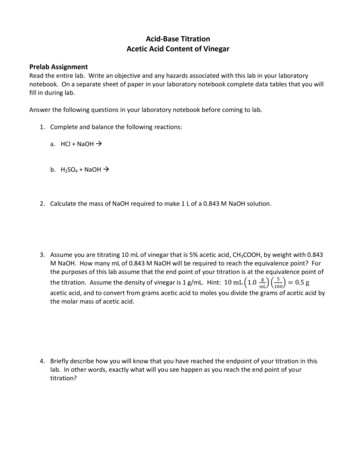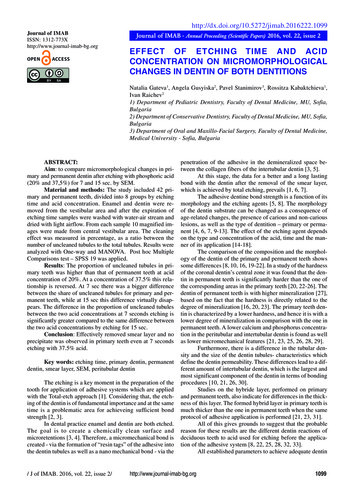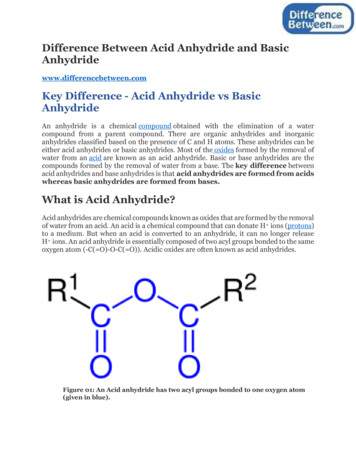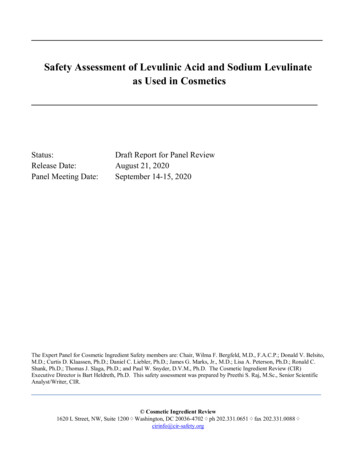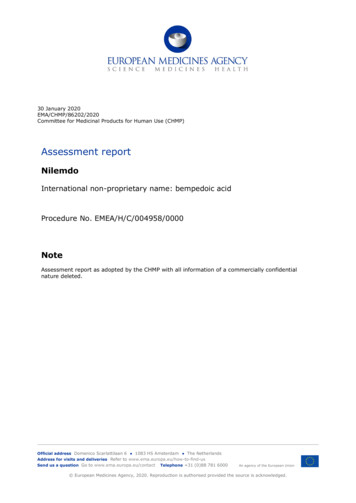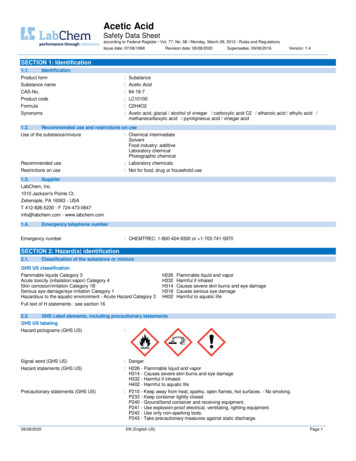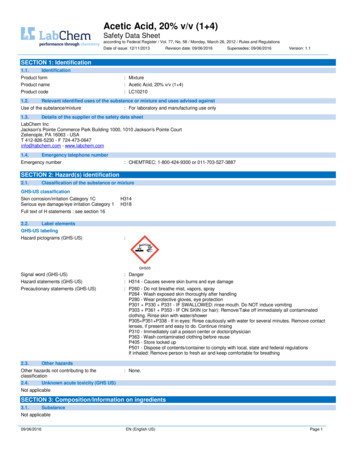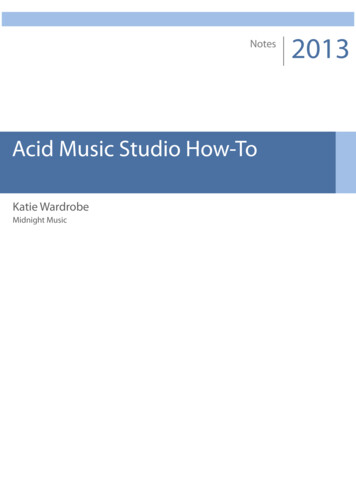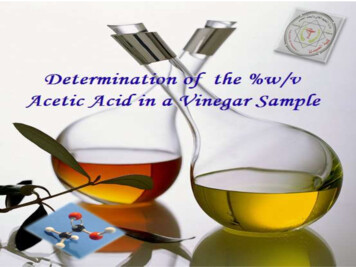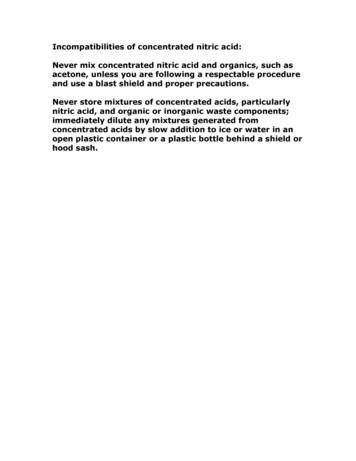
Transcription
Chapter 5: Electrolyte and Acid–Base Disorders inMalignancyAnushree C. Shirali, MDSection of Nephrology, Yale University School of Medicine, New Haven, ConnecticutINTRODUCTIONRenal complications in cancer patients include AKI,hypertension, or electrolyte and acid–base disorders.Of the latter, there are various types that share theability to increase morbidity and mortality, delaytreatment, and decrease quality of life. Understanding the etiology of electrolyte and acid–base abnormalities in cancer patients is critical to promptrecognition and appropriate treatment so that thesecomplications may be avoided. This section of theOnco-Nephrology Curriculum will review the pathophysiology, clinical presentation, and managementof electrolyte and acid–base abnormalities in patientswith malignancies. Specifically, disturbances in thefollowing will be reviewed: 1) electrolytes: disordersof sodium, potassium, calcium, magnesium, andphosphorous; and 2) acid–base: metabolic acidosis.BACKGROUND, EPIDEMIOLOGY, ANDSPECIFIC DISORDERSElectrolyte and acid–base disturbances are common in cancer patients, either due to the malignancy or treatment of the malignancy. Forexample, a patient may develop metabolic acidosisfrom lactate produced by disseminated lymphoma or from chemotherapy-induced diarrhea.Published statistics are not robust for each type ofelectrolyte or acid–base disorder, but there are dataon those associated with greater morbidity or mortality, such as hyponatremia. In one such analysis ofcancer-related admissions, 47% of patients withmostly solid tumors had hyponatremia, and ofthese, 11% had moderate (sodium [Na] 120–129mEq/L) to severe (Na , 120 mEq/L) hyponatremia(1). This is disproportionately higher than thehyponatremia prevalence rates of 15%–30%reported for general medicine admissions (2). Incancer patients with nonsolid tumors, rates ofhyponatremia are less. For example, in acuteAmerican Society of Nephrologyleukemia, the prevalence of hyponatremia is only10%, whereas the prevalence of hypokalemiaranges between 43% and 64% (3). This suggeststhat differences in pathophysiologic mechanismsmay drive unique electrolyte disorders in differentmalignancies. In the next sections, the clinical features, pathophysiology, and treatment of the mostcommon electrolyte and acid–base disorders in cancer patients will be considered.HyponatremiaCancer is a common etiology for hyponatremia in thehospitalized patient, accounting for 14% of cases in aprospective observational cohort (4). Similar to reports on hyponatremia in the general population,lower serum sodium concentration is associatedwith increased hospital length of stay and 90-daymortality (1). In patients with small-cell lung cancer(SCLC), in those who had hyponatremia prior to chemotherapy initiation, failure to achieve normonatremiawithin the first two cycles of chemotherapy was apredictive marker for decreased survival (5).Hyponatremia associated with cancer may haveseveral potential etiologies (Table 1). Regardless of theetiology, patients may be asymptomatic with mild tomoderate disease but may experience headache, fatigue, and mental status changes with moderate tosevere hyponatremia. Examination findings such asfrank or orthostatic hypotension in volume depletionor edema in the third-spacing states of cirrhosis maypoint to potential causes. In conjunction with examination data, urine studies are indispensable, withurine sodium ,20 mEq/L reflecting the sodium avidity of volume depletion and urine sodium .40 mEq/Lsuggesting the syndrome of inappropriate antidiureticCorrespondence: Anushree Shirali, Section of Nephrology, YaleUniversity School of Medicine, PO Box 208029, New Haven,Connecticut 06520-8029.Copyright 2016 by the American Society of NephrologyOnco-Nephrology Curriculum1
Table 1. Common mechanisms for hyponatremia in the cancer patientEtiology of hyponatremiaPseudohyponatremiaReduced water excretionDecreased circulating volumeDecreased effective circulating volumeSIADHNonosmotic stimuli for ADHSalt wastingClinical examples specific to the cancer patientParaproteinemiasUnderlying CKD or AKINausea, vomiting, nasogastric suctioning, and diarrhea;hematemesis or hematochezia (gastrointestinal malignanciesor steroid-induced ulcer disease)Underlying or new onset of CHF, cirrhosis, ascites, severehypoalbuminemia, veno-occlusive diseaseTumor release of ADH: SCLC and head and neck cancerChemotherapy: cyclophosphamide, cisplatin/carboplatin, vincristine,vinblastineOther drugs: SSRIs, NSAIDsPain, nausea, vomitingCisplatinADH, antidiuretic hormone; CHF, congestive heart failure; SIADH, syndrome of inappropriate ADH secretion; NSAIDs, nonsteroidal anti-inflammatory drugs; SCLC,small cell lung cancer; SSRI, selective serotonin reuptake inhibitors.hormone secretion (SIADH) in a euvolemic patient or rarely saltwasting due to cisplatin therapy.Although patients with cancer have hyponatremia due tomany etiologies (Table 1), SIADH is the most common etiology that is directly attributable to cancer. This is because cancer patients have nonvolume and nonosmotic stimuli forantidiuretic hormone (ADH) release, such as nausea/vomitingand pain or medications such as cyclosphosphamide. An additional factor is the paraneoplastic release of ADH from tumor subtypes, notably SCLC and head and neck cancer (6).Finally, several chemotherapy drugs have been linked tohyponatremia via potentiation of ADH release or action, including vinblastine, vincristine, and cyclophosphamide (7).Cisplatin is another antineoplastic agent linked tohyponatremia through a mechanism that involves salt wastingat the loop of Henle (8). Ten percent of patients on cisplatintherapy at a single center developed hyponatremia with a highurine sodium concentration but with profound volume depletion. Thus, these patients required volume expansion withsaline to correct their hyponatremia, in contrast to patientswith SIADH who are volume replete. This underscores theneed for correct etiologic diagnosis of hyponatremia to provide appropriate therapy. Therapy must be tailored for thepatient, the underlying diagnosis, and the severity of hyponatremia. Severe hyponatremia with serum Na concentration,110 mEq/L and neurologic symptoms may need 3% hypertonic saline for acute management. Fluid restriction is themainstay of treatment for SIADH, with salt tablets and loopdiuretics as adjunctive therapy. However, these measures canhinder quality of life in the cancer patient, and thus, aquareticsthat inhibit the vasopressin type 2 receptor (V2-R) to inhibitwater reabsorption in the collecting duct are suggested formanagement of hyponatremia secondary to SIADH in cancerpatients if other therapies are not feasible or effective. However, the data on their clinical utility in cancer patients are sparse.In a small, single center safety and efficacy study, tolvaptan, aV2-R antagonist, was superior to placebo in the correction ofhyponatremia but did not decrease hospital length of stay (LOS)2Onco-Nephrology Curriculumor improve cognitive testing (9). In addition, chronic tolvaptanuse may be limited by expense and cumulative dose-dependenthepatotoxicity (10).HypokalemiaSimilar to hyponatremia, hypokalemia is commonly encountered in cancer patients, resulting from cancer-distinct andcancer-specific causes (Table 2) and, more commonly, from acombination of the two. Proper diagnosis starts with excludingpseudohypokalemia from postphlebotomy transcellularshifts, which is seen in patients with profound leukocytosiswhose blood samples are not refrigerated or immediately analyzed. Once true hypokalemia is confirmed, measurement ofurine potassium and the trans-tubular potassium gradient canbe helpful in analyzing renal potassium wasting (11).In cancer-distinct causes, chemotherapy leads to hypokalemia either indirectly via side effects of decreased appetite/intake, vomiting, and diarrhea or directly via renal tubulareffects. For example, ifosfamide causes renal potassiumwasting, either as an isolated proximal tubulopathy or Fanconisyndrome (FS), which may persist after treatment. Fifteenpercent of pediatric cancer patients who received ifosfamidetherapy exhibited persistent hypokalemia months to years afterthe end of treatment (12).Cancer-specific causes of hypokalemia include tumors thatsecrete ectopic adrenocorticotropin hormone (ACTH) such asSCLC, thymus or bronchial carcinoid, thyroid medullarycarcinoma, or neuroendocrine tumors (13). Although uncommon, these tumors stimulate renal potassium wastingvia excessive cortisol release that activates the mineralocorticoidpathway. Accordingly, other features of hypercortisolemiaare also present including pigmented skin, diabetes, and hypertension (13). Another cancer-specific etiology for hypokalemia is evident in acute myeloid leukemia (AML), M4 and M5subtypes, which has been long associated with hypokalemia(14,15). These malignancies increase serum lysozymeand lysozymuria, leading to the hypothesis that lysozymemediated tubular injury leaks potassium (and other electrolytes)American Society of Nephrology
Table 2. Cancer-distinct and cancer-specific causes of hypokalemia in the patient with malignancyEtiology of hyponatremiaPseuodohypokalemiaRedistribution into cellsPoor intakeExtrarenal lossesRenal lossesCancer distinctCancer specificPhlebotomy error with tight tourniquetUse of GM-CSF, vitamin B12Anorexia, nausea, mucositisVomiting, diarrhea from chemotherapy or radiation enteritisHypomagnesemia, Fanconi syndrome with chemotherapyClonal leukocytosis with leukemiasBlast crisis with leukemiasTumor-induced dysphagiaVIPoma, villous adenoma (rare)Lysozymuria, Fanconi syndrome from light chaininjury (myeloma), ectopic ACTH productionACTH, adrenocorticotropin hormone; GM-CSF, granulocyte macrophage colony stimulating factor; VIP, vasoactive intestinal peptide.into urine. Another putative mechanism may be renin-likeactivity by AML blast cells stimulating the mineralocorticoidpathway (16).The potassium losses in these cases may be profound andrequire aggressive replacement. The choices for replacementare the same as those utilized for hypokalemia in the noncancerpatient (11), but it should be noted that given the difficultycancer patients may have with oral intake due to nausea,mucositis, etc., intravenous dosing is often necessary. Hypokalemia treatment is also ineffective if hypomagnesemia remains uncorrected, due to unchecked potassium losses via therenal outer medullary K1 channel (ROMK) channel in distalnephron tubular cells (17).panitumumab, display tumoricidal activity against a variety ofcancers, but they also prevent the insertion of a magnesiumchannel, transient receptor potential M6 (TRPM6), into theapical membrane of distal tubular cells (Figure 1) (18). As a result, magnesium cannot be reabsorbed from the tubular lumenand serum magnesium levels fall, affecting 10%–36% of patientsin early clinical trials of cetuximab (7). A fractional excretion ofmagnesium .15% in a hypomagnesemic patient indicates renalwasting. Treatment involves replacing magnesium, and intravenous dosing is usually needed because diarrhea is a dose-limitingadverse effect of oral magnesium. Fortunately, renal magnesiumwasting subsides over time following discontinuation of theEGFR antagonist. However, this is not the case with the platindrugs, where renal magnesium wasting can be permanent.Hypomagnesemia in cancer patientsHypomagnesemia in the cancer patient may be due to decreasedintake or from renal magnesium wasting. Renal losses ofmagnesium are principally due to chemotherapy-mediatedinjury to the distal nephron, the site of active magnesiumreabsorption in the nephron. This has been noted with cisplatin,but a rising number of cases are being attributed to drugs thattarget the epidermal growth factor receptor (EGFR) pathway.Monoclonal antibodies against EGFR, such as cetuximab andHypercalcemiaTwenty percent to 30% of cancer patients experience hypercalcemia during the course of their malignancy (19), and this ispredictive of poor prognosis (20). Hypercalcemia of malignancyuses one of two mechanisms: 1) osteolytic release of local calcium from bone directly involved by cancer cells or 2) stimulation of osteoclast activity by release of the tumor-derivedendocrine factors. Although these mechanisms are distinct,Figure 1. Absorption of magnesium from the tubular lumen is via an EGFR-dependent apical channel, TRPM6. This pathway isinhibited by use of anti-EGFR monoclonal antibodies such cetuximab. EGF, epidermal growth factor; EGFR, epidermal growth factorreceptor; TRPM6, transient receptor potential M6. Red line denotes inhibition of interaction.American Society of NephrologyOnco-Nephrology Curriculum3
the resultant hypercalcemia in either case may be mild andasymptomatic, moderate and accompanied by nausea/vomiting,constipation, bone pain, and fatigue, or severe and manifested byconfusion and coma (21). It is important to correct serum calcium concentration for hypoalbuminemia so that hypercalcemialevels can be properly graded.Among solid tumors, primary bone cancers and metastaticbreast or prostate cancer stimulate osteolysis, which correlateswith the overall tumor burden. Although metastases do notoccur in nonsolid tumors, osteolysis may be stimulated by avariety of immune and nonimmune pathways in multiplemyeloma. Both result in release of sequestered calcium frombone with the common pathway centered on the interactionbetween receptor activator of nuclear factor-kB (RANK),which is present on osteoclasts and their precursors, andRANK ligand (RANKL), which is present on osteoblast andbone marrow stromal cell surfaces (22). The putative mechanism involves RANKL binding to its cognate receptor RANKthrough the influence of parathyroid hormone (PTH) andPTH-related peptide (PTHRP), which subsequently increasesosteoclastic activity and release of local calcium (21).Tumor-derived endocrine factors are responsible for thehumoral hypercalcemia of malign
need for correct etiologic diagnosis of hyponatremia to pro-vide appropriate therapy. Therapy must be tailored for the patient, the underlying diagnosis, and the severity of hypona-tremia. Severe hyponatremia with serum Na concentration,110 mEq/L and neurologic symptoms may need 3% hyper-tonic saline for acute management. Fluid restriction is the mainstay of treatment for SIADH, with salt .
